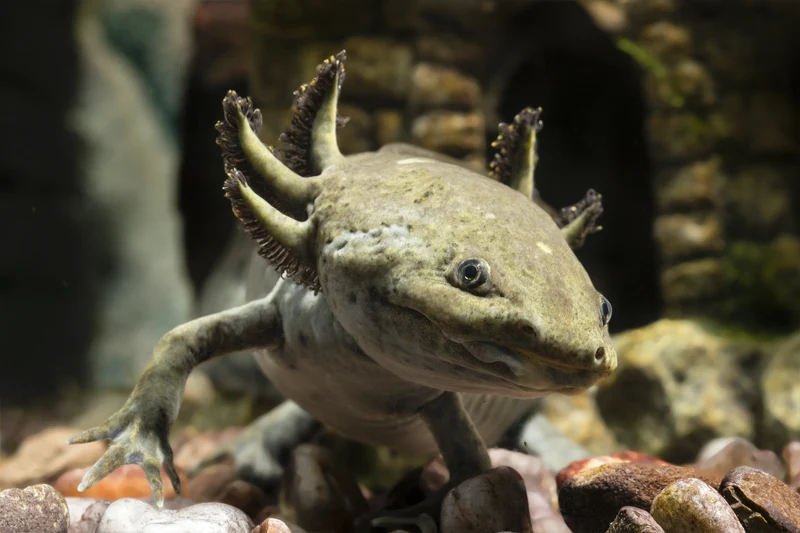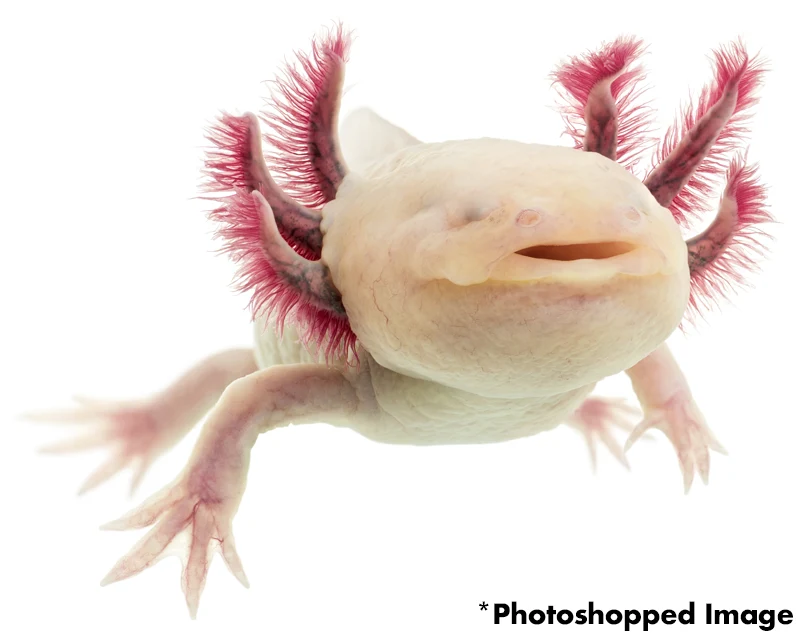Are Axolotls Blind?

Axolotls (Ambystoma Mexicanum) are among the most well-known amphibians on earth. Their external gills, striking colorations, and ever-present smile are enough to win the heart of anyone. For that reason, they’re popular pets!
First-time axolotl owners occasionally watch in horror as their beloved pet bumps into the glass, plants, and other decorations in the aquarium. Naturally, this prompts the question, “Are axolotls blind?” It’s a good question, too.
No, axolotls are not blind but they have poor vision. Also, they don’t have eyelids and they’re sensitive to light.
The rest of this page includes feeding/safety tips and information about light sensitivity. Keep reading until the end to learn about eyeless mutant axolotls!
How Axolotls Find Food With Poor Vision
So, axolotls are not blind in most cases, they just have poor eyesight. Now what? If they can’t see very well, how do they find food?
It may surprise you to learn that axolotls have numerous sensory systems. They find food primarily via smell and vibrations in the water.
- Axolotls have an olfactory system[1]. The olfactory system is a structure that serves a sense of smell.
- Axolotls have a lateral line system[2]. A lateral line system is a sensory system that allows animals (aquatic vertebrates like fish and amphibians) to detect movement in the surrounding water.
Despite having poor vision, axolotls are capable of finding food by way of smell and sensing movement in the water.
Axolotls Are Sensitive to Light
On top of having poor vision, axolotls are sensitive to light. They’re not capable of protecting their eyes with eyelids because they don’t have eyelids.
Also, axolotls are nocturnal. Nocturnal species are most active at night, in dark environments.
Experienced hobbyists will confirm that axolotls react poorly when changing their aquarium’s light. It’s akin to having someone shine a bright light in your eyes, only they’re unable to cover their eyes because, again, they don’t have eyelids.
Finally, research suggests that albino axolotls are more sensitive to light than normally pigmented ones. According to this study, melanin appears to decrease sensitivity to light in the iris[3].
Be mindful of using lights in your axolotl’s enclosure! Especially if your axolotl is albino.
Related: 10 Most Popular Pet Amphibians
Eyeless Mutant Axolotls

Axolotls are amazing for many reasons. They can regenerate limbs, organs, and damaged tissue. They come in different colors, from natural to albino, and even GFP (green fluorescent protein) that makes them glow. But few people know about eyeless axolotls.
Eyeless mutant axolotls are just that; eyeless. The rare mutation of gene e prevents optic vesicles from forming. This mutation affects more than their eyes, too. According to one study, eyeless mutant axolotls are sterile [4]. Interesting, right? Keep reading, it gets better.
Researchers grafted eyes into eyeless axolotls to see if they would regain vision. Turns out, that’s what happened. Eyeless mutant axolotls that received grafted eyes during an embryonic stage established retinotectal connection and restored almost normal vision[5].
Sure, your pet might be a bit clumsy due to poor vision, but some axolotls don’t have eyes at all.
TLDR; Are Axolotls Blind?
Nope, axolotls are not blind. They simply have poor vision. They don’t have eyelids and they’re sensitive to light, too. Also, research suggests that albino axolotls are more sensitive to light. Be mindful of this if you’re planning to keep one as a pet!
Axolotls can smell and sense vibrations in the water. These senses help them locate prey and other food sources.
References
- Eisthen, Heather L., et al. “Anatomy and Forebrain Projections of the Olfactory and Vomeronasal Organs in Axolotls <I>(Ambystoma Mexicanum)</I>” Brain, Behavior and Evolution, vol. 44, no. 2, 1994, pp. 108–24. Crossref, https://doi.org/10.1159/000113574.[↩]
- Northcutt, R. G., and H. Bleckmann. “Pit Organs in Axolotls: A Second Class of Lateral Line Neuromasts.” Journal of Comparative Physiology A, vol. 172, no. 4, 1993, pp. 439–46. Crossref, https://doi.org/10.1007/bf00213525.[↩]
- Barr, L. “Hypersensitivity to Light of the Iris (Sphincter Pupillae) of the Albino Axolotl (Ambystoma Mexicanum).” Journal of Experimental Biology, vol. 137, no. 1, 1988, pp. 589–96. Crossref, https://doi.org/10.1242/jeb.137.1.589.[↩]
- EPP, LEONARD G. “A Review of the Eyeless Mutant in the Mexican Axolotl.” American Zoologist, vol. 18, no. 2, 1978, pp. 267–72. Crossref, https://doi.org/10.1093/icb/18.2.267.[↩]
- Hibbard, Emerson, and Richard L. Ornberg. “Restoration of Vision in Genetically Eyeless Axolotls (Ambystoma Mexicanum).” Experimental Neurology, vol. 50, no. 1, 1976, pp. 113–23. Crossref, https://doi.org/10.1016/0014-4886(76)90239-9.[↩]
